October 3, 2006 — They may be amongst the most well listened to words ever spoken and yet what actually was said wasn't very well heard. As his left boot first touched the lunar surface, Apollo 11 commander Neil Armstrong radioed back, "That's one small step for a man, one giant leap for mankind" and most of those words transmitted successfully. Missing was the 'a' between 'for' and 'man', leading to a debate as to whether Armstrong misspoke or the 'a' was lost in the static.
The answer, as it turns out, was always there but it took nearly 40 years for technology to advance to the point it could reveal it.
As first reported by the Houston Chronicle, Peter Shann Ford, a former television journalist whose work now as a computer programmer enables physically handicapped people to use their nerve impulses to communicate (such as Dr. Stephen Hawking), was able to use software and his understanding of speech physiology to rediscover the missing 'a'. Ford contacted James Hansen, Armstrong's authorized biographer with his findings, who organized for Ford to meet with Armstrong and National Air and Space Museum historians in Washington, D.C.
"I have reviewed the data and Peter Ford's analysis of it and I find the technology interesting and useful," said the man who made the small step. "I also find his conclusion persuasive," said Armstrong at the close of their meeting.
In a written statement, Hansen said "Peter has authored a remarkable paper entitled, Electronic Evidence and Physiological Reasoning Identifying the Elusive Vowel 'a' in Neil Armstrong's Statement on First Stepping onto the Lunar Surface. In it, Peter concludes that Armstrong did, in fact, say 'one small step for a man.'"
Presented below, with permission of its author, is Peter Shann Ford's paper complete with illustrations. He invites those who are inclined to download the same software and audio file that he used to reach his findings and test his conclusions.
Excerpts of a NASA recording of the Apollo 11 mission lunar landing are available on the internet, titled "Sounds from Apollo 11". A 259 kilobyte, 24.113 second duration WAV file is downloadable from that page.
Figure 1 shows GoldWave v5.14 digital sound editing software displaying the WAV file's time-based amplitude and frequency variations consistent with the words and sounds uttered by Neil Armstrong as he first stepped from the Lunar Excursion Module (LEM) onto the surface at Tranquility Base. (Click on Figure for enlarged view).
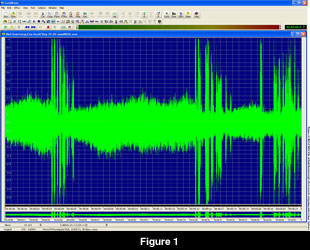
Figure 2 shows annotations and correlation with Neil Armstrong's words, "I'm gonna step off the LEM now" and, "That's one small step for a man, one giant leap for mankind".
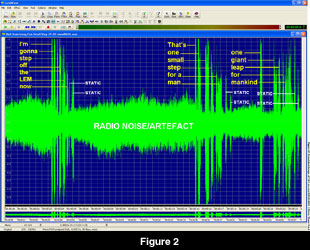
The Editor:
The GoldWave editor displays two graph areas: the larger upper area with a dark blue background, grey graph coordinate lines and green plot lines; and the smaller narrow area with similar colour scheme below it.
The recorded sounds, including radio noise and electronic artefact including bursts of static, and words, are represented by the irregular vertical narrow green lines stretching to the top and the bottom area of the dark blue graphs. The irregular broad green strip running horizontally from left to right across the midline of both graphs represents background electronic noise and artefact from the radio communications link between the LEM and Mission Control in Houston. (For more on the radio links for video and sound via Parkes Observatory, Australia and Goldstone, California see Figure 18).
The numbers displayed immediately below each graph area represent elapsed time, in hours, minutes and seconds, displayed at one second intervals. These two numerical displays always indicate elapsed time but their scale changes according to the magnification of the graph, determined by the size of the data area selected. The numbers on the row second from the bottom indicate that this is a monophonic recording (Mono), that the cursor which moves as sound is played back is at elapsed time 24.113 seconds, and that this selection runs from Zero (0.000) to 24.113 seconds. The numbers on the bottom line indicate the source, amplitude magnification and digital size, frequency and digital sampling rate of the WAV file.
By highlighting the right portion of the graph, the sentence, "That's one small step for a man, one giant leap for mankind" can be isolated. Figure 3 illustrates this.

Using the editor's "Trim" function on the darkened area leaves the highlighted area displayed across the editing screen. It thus appears horizontally stretched. Figure 4 illustrates this.
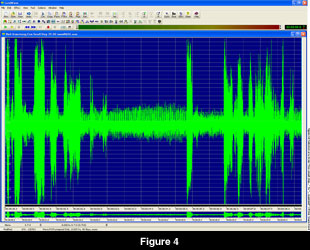
Using the editor to highlight a 1.573 second sample of electronic artefact at a break in Neil Armstrong's words enables the editor to capture data ranges for removal. Figure 5 illustrates this.
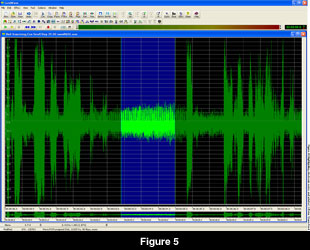
The editor eliminates this data range from the screen, leaving Neil Armstrong's words more clearly discernible. This action does not change critical voice characteristics. Figure 6 illustrates this.
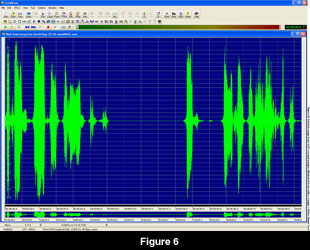
Figure 7 shows the same sound graph annotated.
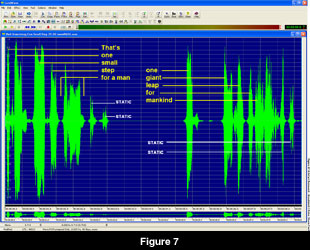
Figure 8 illustrates using the editor to Trim the phrase "for a man".
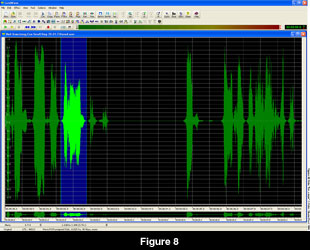
Figure 9 illustrates the graph expansion isolating the phrase "for a man".
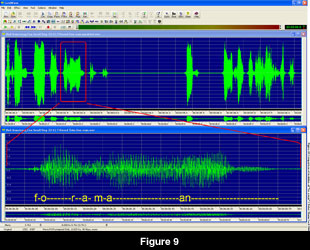
Figure 10 illustrates the annotated file after the Trim function to isolate the phrase "for a man".
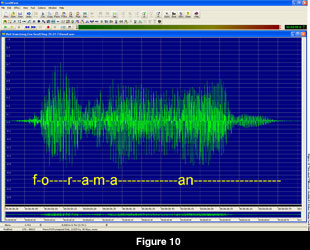
Neil Armstrong says "for" in a clearly graphed sound wave. He says "man" in two syllables, beginning with an introductory pressure wave on "m", through an "a-a" extension which decays toward a final pressure wave at the conclusion of"n". An additional sound wave exists between "for" and "man", defined in the following. figures.
Figure 11 illustrates highlighting from the onset of the "for" sound wave to the final decay of the "man" sound wave. The highlighted sample is 0.638 seconds in duration (see Figure 11).
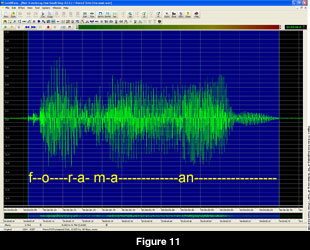
Figure 12 illustrates the isolated 0.638 second sample "for a man" full-screen and annotated.
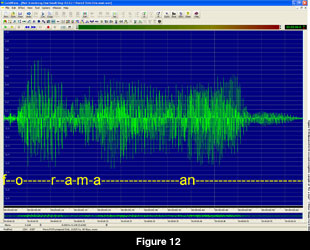
Figure 13 illustrates the onset of the "for" sound wave at 0.000 seconds in this sample, and its minimum point of decay at 0.136 seconds into the sample: it additionally illustrates the onset of the "man" sound wave at 0.171 seconds into the sample and its final decay at 0.638 seconds.
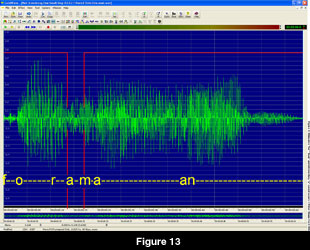
Figure 14 illustrates a magnification of the sound wave between the minimum point of decay of "for" at 0.136 seconds and the point of onset of"man" at 0.171 seconds. This 0.035 second sound wave is the elusive "a" — thirty-five thousandths of a second in duration.
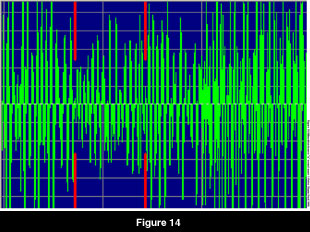
Figure 15 annotates this magnified sample.
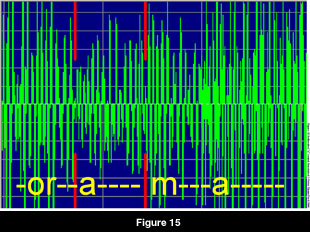
This 0.035 second sound wave is consistent with the sound made in the lingual (tongue) buccal (mouth) labial (lips) transition from the terminal consonant "r" in "for" to a vowel "a" to the introductory "m" in "man". It is not consistent with the sound made in the lingual- buccal- labial transition from the terminal "r" in "for" directly to the introductory "m" in "man", as in "for man".
Figure 16 illustrates the sequence of both transitions.
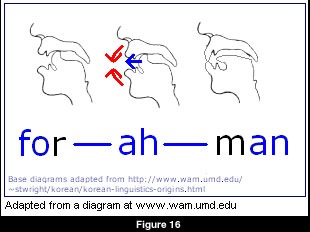
In the transition from "for" to "a" to "man" the tongue is curled into the terminal "r" of "for" and uncurls for the "a" before the lips close for "m" in "man" creating a pressure wave consistent with the 0.035 second sound wave Figure 13.
In the transition from "for" to "man" (as in the statement "for man") the lips close for the "m" of "man" while the tongue is still curled for the "r" of "for" precluding the creating of the pressure wave consistent with the sound wave of "a".
Control Comparison:
This illustration could be tested and further verified if there were a control phrase in the same sentence with which to compare the phrase "for a man".
In reviewing this paper, Ms. Rano Singh, a Physiotherapist with a Masters in Biomechanics has noted that the graphs shown above indicate an inconsistency in the sound waves representing Neil Armstrong's phrases "for a man" in the first part of the sentence and "for mankind" in the second part.
Figure 17 illustrates this inconsistency. If the phrase "for mankind" (shown in the top third of Figure 17) may be used as a control, a comparison with the phrase "for a man" (in the bottom third of Figure 17) shows the clear presence of an additional sound wave between "for" and "man" in the phrase "for a man" and the absence of any such sound wave between "for" and "mankind" (shown in the middle third of Figure 17).
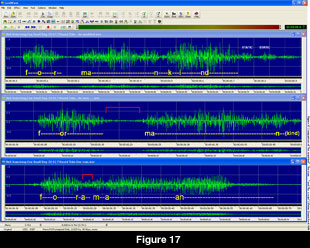
Conclusion:
Astronaut Neil Armstrong's arrival on the moon followed a distinguished career as a combat pilot, test pilot, commander of Gemini VIII for the first docking in space, and backup commander for Apollo 8. His professionalism, precision and coolness under pressure were established long before and highlighted when he took control of the lunar landing from the autopilot, flew beyond a hazardous area and landed Eagle manually. He recalls he formulated the sentence, "That's one small step for a man, one giant leap for mankind" in the LEM in the hours between landing and stepping onto the lunar surface. It is a concise, eloquent statement for the ages at a unique milestone for our species. It seemed highly unlikely that he would utter it incorrectly.
This paper proves, with an analysis and results that are independently repeatable, that he did indeed say the sentence completely and correctly.
Additional Notes:
1. Notes on the video and radio downlink from Tranquility Base to Mission Control, Houston during the first EVA onto the lunar surface, provided here by John Sarkissian, Operations Scientist at the Parkes Radio Observatory, Australia.
"The full spectrum of the radio signal transmitted to the Earth contained both the telemetry and the TV separately. The TV was frequency modulated (FM) on the carrier, and the subcarriers, which were phase modulated (PM) at several different frequencies, and contained the telemetry information including the audio. So, while the majority of the TV of the moonwalk broadcast to the world was via the 64m Parkes Radio Telescope, Australia, the audio downlink broadcast to the world (and recorded) was exclusively via the 64m Goldstone, California antenna.
Three tracking stations were receiving the signal simultaneously - Goldstone, Parkes, and Honeysuckle Creek also in Australia. A controller at Mision Control in Houston would select the TV that would be broadcast to the world. During the first 8 minutes and 51 seconds of the TV broadcast, the source of the TV that was broadcast to the world alternated between the Goldstone and Honeysuckle Creek tracking stations. The grainy TV images of Armstrong stepping onto the Moon was sourced from the NASA tracking station at Honeysuckle Creek outside Canberra. At 8 minutes and 51 seconds into the broadcast, the TV was finally switched to Parkes. Since the Parkes TV picture quality was superior to the other two stations, NASA remained with Parkes as the source of the TV pictures for the remainder of the over 2.5 hour broadcast. Now, while the TV was through Parkes (and the other stations at the beginning) the audio downlink used for the broadcast was exclusively via the Goldstone station throughout. Therefore, the audio you used to analyse Armstrong's words were most likely sourced from Goldstone and not Parkes. That is, the TV pictures and the audio were sent separately on the one signal transmitted from the Moon."
2. Notes on the diagram of the mouth and the physiology of consonants "r" and "m" sequenced with vowel formation
[Presently being edited for inclusion by October 9, 2006]
